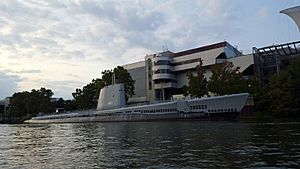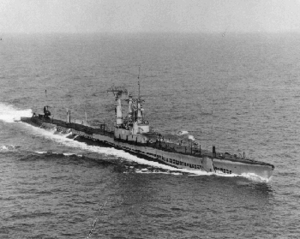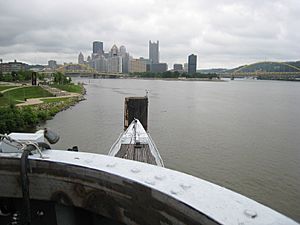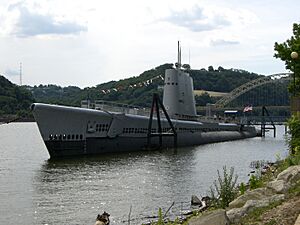USS Requin facts for kids

Requin in dock on the Ohio River in Pittsburgh in 2017.
|
|
Quick facts for kids History |
|
|---|---|
| Name | USS Requin |
| Builder | Portsmouth Naval Shipyard, Kittery, Maine |
| Laid down | 24 August 1944 |
| Launched | 1 January 1945 |
| Commissioned | 28 April 1945 |
| Decommissioned | 2 December 1968 |
| Stricken | 20 December 1971 |
| Fate |
|
| General characteristics | |
| Class and type | Tench-class diesel-electric submarine |
| Displacement | |
| Length | 311 ft 9 in (95.02 m) |
| Beam | 27 ft 4 in (8.33 m) |
| Draft | 17 ft (5.2 m) maximum |
| Propulsion |
|
| Speed |
|
| Range | 11,000 nautical miles (20,000 km) surfaced at 10 knots (19 km/h) |
| Endurance |
|
| Test depth | 412 ft (130 m) |
| Complement | 10 officers, 71 enlisted |
| Armament |
|
The USS Requin (pronounced "RAY-kwin") was a special type of submarine called a Tench-class submarine. It was named after the French word for "shark." This submarine was the only ship in the United States Navy to have this name. Since 1990, the Requin has been a cool museum ship. You can visit it at the Carnegie Science Center in Pittsburgh, Pennsylvania.
Contents
Building and Starting Service
The Requin was built at the Portsmouth Navy Yard in Kittery, Maine. Its construction began on August 24, 1944. The submarine was officially launched into the water on January 1, 1945. It was then put into service on April 28, 1945. Commander Slade Cutter was its first leader.
The Requin was first built with more weapons than other submarines. It had an extra 5-inch deck gun and two rocket launchers. These were meant to help attack Japan during a planned invasion called Operation Downfall. However, World War II ended before the Requin could join any battles.
Early Missions and Changes
After testing, the Requin sailed to Hawaii in June 1945. It joined the Pacific Fleet in July. But just two weeks later, World War II ended. The Requin was called back to the Atlantic Ocean.
In September 1945, the Requin arrived in Staten Island, New York. Its new job was to act as a target for sonar training. Sonar is a system that uses sound waves to detect objects underwater. In January 1946, it moved to Key West, Florida.
From August to November 1946, the Requin went through a big change. It was turned into a radar picket submarine. This meant it would use radar to spot enemy planes or ships from far away. To do this, some of its torpedo tubes and guns were removed. It also got new radar equipment. In October 1946, George L. Street III, a hero from the war, became its new commander.
Radar Picket Operations
After its changes, the Requin continued its work in the Atlantic. In 1947, it traveled north and even crossed the Arctic Circle. On January 20, 1948, its official name changed to SSR-481, with "SSR" meaning "radar picket submarine." It received more radar upgrades.
In May 1949, the Requin went on its first trip to the Mediterranean Sea. It worked with the Sixth Fleet there. After returning, it moved to Norfolk, Virginia. It continued to operate in the western Atlantic and the Caribbean Sea. The submarine went on more trips to the Mediterranean in 1951 and 1952.
In 1953, the Requin had another major update. Its last anti-aircraft gun was removed. It continued its duties until November 1957.
Becoming a Regular Submarine
From June to August 1959, the Requin went through another big change. All its radar equipment was removed. Its shape was also made smoother to help it move faster underwater. It was then reclassified as a regular attack submarine, SS-481. It rejoined its squadron in Norfolk.
The Requin performed missions along the East Coast and in the Caribbean. In 1961, it practiced with the aircraft carrier USS Saratoga. The Requin pretended to attack the carrier with torpedoes. On September 20, 1963, the Requin completed its 5,000th dive!
In 1966, the Requin sailed around South America. It did exercises with different navies there. Its last trip to the Mediterranean was from April to July 1967.
On June 8, 1967, the Requin was doing exercises when it heard that another U.S. ship, the USS Liberty, was under attack. The Requin's crew got ready to help, but they were told to surface and go to Crete instead.
In May 1968, the Requin helped search for the missing nuclear submarine USS Scorpion. In June 1968, it was reclassified again as an auxiliary submarine, AGSS-481. It began to prepare for retirement.
Retirement and Becoming a Museum
The Requin was officially taken out of service on December 3, 1968. In February 1969, it was towed to St. Petersburg, Florida. There, it was used as a training vessel for the Naval Reserve. On December 20, 1971, its name was removed from the official list of Navy ships.
On June 17, 1972, the Requin was given to a non-profit group in Tampa, Florida. It became a tourist attraction docked in the Hillsborough River. It stayed there until 1986, when the group ran out of money. The Requin was closed and left abandoned for four years.
In 1990, Senator John Heinz helped arrange for the Requin to move to Pittsburgh. It was towed to a shipyard for repairs. On August 7, it began a long journey. It was lifted onto barges and traveled up the Mississippi River and Ohio River to Pittsburgh.
On September 4, the Requin arrived at the Kamin Science Center (now the Carnegie Science Center). On October 20, 1990, the Requin was opened as a memorial and museum exhibit. Today, you can explore this historic submarine and learn about its past!
Awards
Former Crew
- Lyle Gramley, who served from 1946 to 1947.
See also








